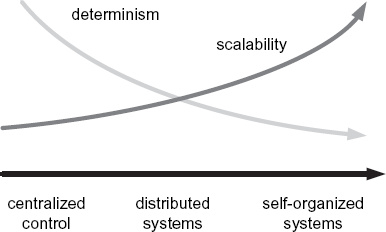1.2. Principles of Biologically Inspired Networking
There are several key factors which can be observed in biological systems. Especially, features such as self-organization and robustness are of great importance when biological methods are applied to computer networks. However, there is also a trade-off to make when it comes to considering self-organized, distributed systems over those which are centrally controlled. Although scalability is improved, the approach towards fully distributed topologies comes at a cost of performance. Since there is no global view of the entire network, global optimization of network parameters is no longer feasible. Methods searching for local ad hoc solutions may yield only inferior results, so a trade-off must be found which balances scalability with controllability and performance.
Dressler [] illustrates this trade-off as shown in Figure 1.1. The distinction is made between systems with centralized control and those that are fully self-organized. Distributed systems could be considered as intermediate, hybrid networks which allow the management of large numbers of nodes in a scalable way while preserving the benefits from a centralized control.
Figure 1.1. Trade-off between controllability and scalability in system control

Furthermore, while most computer networks are designed to optimally function under controlled conditions, biologically ...
Get Cognitive Networks: Towards Self-Aware Networks now with the O’Reilly learning platform.
O’Reilly members experience books, live events, courses curated by job role, and more from O’Reilly and nearly 200 top publishers.

